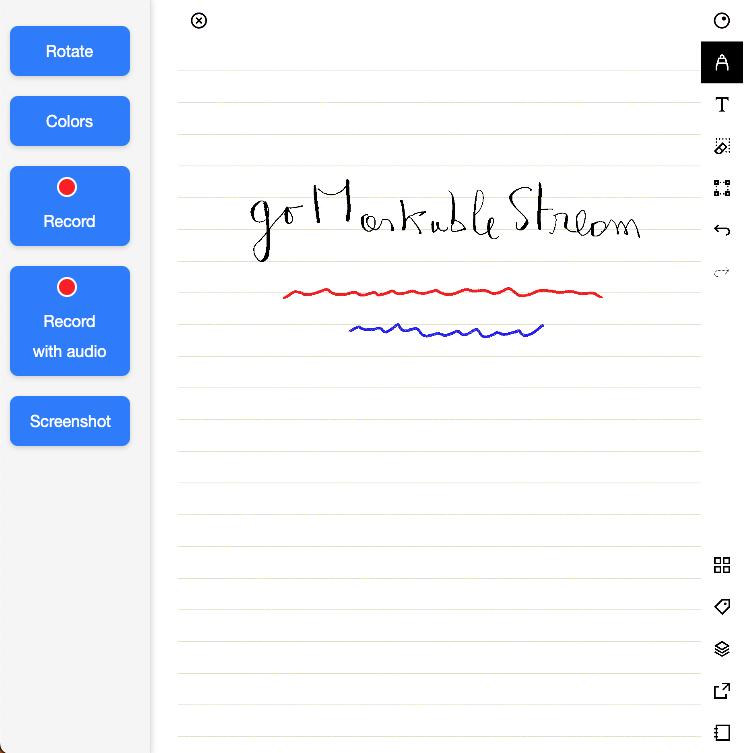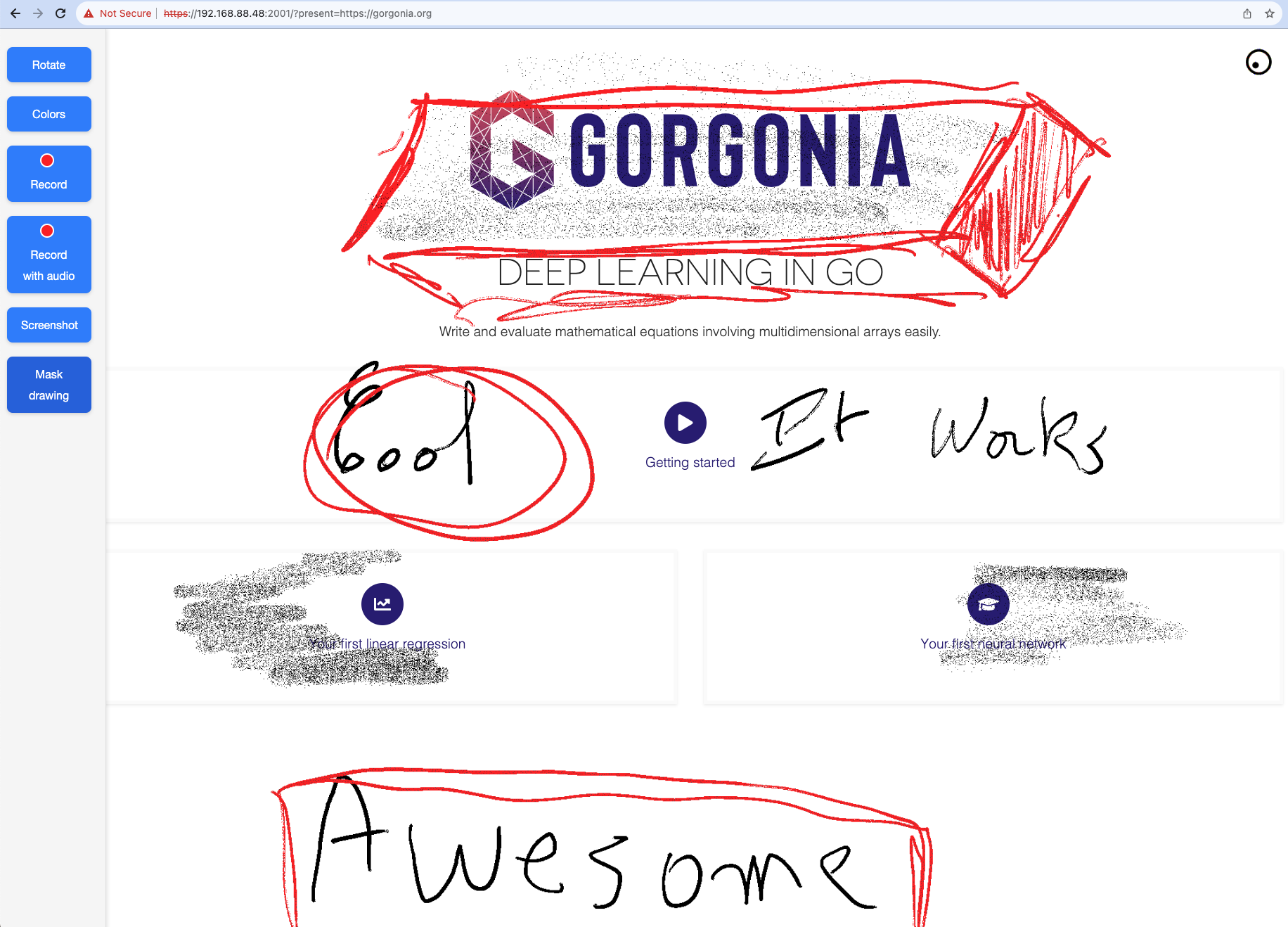goMarkableStream
goMarkableStream

Overview
The goMarkableStream is a lightweight and user-friendly application designed specifically for the reMarkable tablet.
Its primary goal is to enable users to stream their reMarkable tablet screen to a web browser without the need for any hacks or modifications that could void the warranty.
Device support
- Remarkable 2
- Remarkable Paper Pro (see notes below)
Remarkable Paper Pro
Remarkable Paper Pro is in initial support. The application is not yet fully tested on this device and some features may not work as expected.
When running on the Remarkable Paper Pro, RLE_COMPRESSION environment variable must be set to false since it’s not supported.
Version support
- reMarkable with firmware < 3.4 may use goMarkableStream version < 0.8.6
- reMarkable with firmware >= 3.4 and < 3.6 may use version >= 0.8.6 and < 0.11.0
- reMarkable with firmware >= 3.6 may use version >= 0.11.0
Features
- No Warranty Voiding: Operates within the reMarkable tablet’s intended functionality without unauthorized modifications.
- No Subscription Required: Completely free to use, with no subscription fees or recurring charges.
- No Client-Side Installation: Access the screen streaming feature directly through a web browser, with no need for additional software or plugins.
- Color Support: Enhanced streaming experience with color support.
- High Performance: Utilizes WebGL for smooth and efficient performance.
- Laser Pointer: Features a laser pointer that activates on hovering.
- Gesture Support: Full integration with Reveal.js, allowing slide switching directly from the reMarkable.
- Overlay Feature: Allows overlaying over existing websites that support iframe embedding.
- Live Parameter Tweaking: Side menu for live adjustments, including screen rotation.
- Dark Mode: Toggle between light and dark themes for comfortable viewing in any environment.
- Version API: Check the current version via the
/versionendpoint.
Quick Start
localhost> ssh root@remarkable
For version >= 3.6
export GORKVERSION=$(wget -q -O - https://api.github.com/repos/owulveryck/goMarkableStream/releases/latest | grep tag_name | awk -F\" '{print $4}')
wget -q -O - https://github.com/owulveryck/goMarkableStream/releases/download/$GORKVERSION/goMarkableStream_${GORKVERSION//v}_linux_arm.tar.gz | tar xzvf - -O goMarkableStream_${GORKVERSION//v}_linux_arm/goMarkableStream > goMarkableStream
chmod +x goMarkableStream
./goMarkableStream
for version < 3.6
export GORKVERSION=$(curl -s https://api.github.com/repos/owulveryck/goMarkableStream/releases/latest | grep tag_name | awk -F\" '{print $4}')
curl -L -s https://github.com/owulveryck/goMarkableStream/releases/download/$GORKVERSION/goMarkableStream_${GORKVERSION//v}_linux_arm.tar.gz | tar xzvf - -O goMarkableStream_${GORKVERSION//v}_linux_arm/goMarkableStream > goMarkableStream
~/chmod +x goMarkableStream
./goMarkableStream
then go to https://remarkable.local.:2001 and login with admin/password (can be changed through environment variables or disable authentication with -unsafe)
note: remarkable.local. may work from apple devices (mDNS resolution).
Please note the . at the end.
If it does not work, you may need to replace remarkable.local. by the IP address of the tablet.
note 2: you can use this to update to a new version (ensure that you killed the previous version before with kill $(pidof goMarkableStream))
Errors due to missing packages
If you get errors such as wget: note: TLS certificate validation not implemented or -sh: curl: command not found when running through the process above, then some commands are missing on your Remarkable. To avoid having to install additional packages, you can first download goRemarkableStream to your local computer and then copy it over to your Remarkable as follows:
- Run this on your local computer to download goRemarkableStream into the current directory:
localhost> export GORKVERSION=$(wget -q -O - https://api.github.com/repos/owulveryck/goMarkableStream/releases/latest | grep tag_name | awk -F\" '{print $4}')
wget -q -O - https://github.com/owulveryck/goMarkableStream/releases/download/$GORKVERSION/goMarkableStream_${GORKVERSION//v}_linux_arm.tar.gz | tar xzvf - -O goMarkableStream_${GORKVERSION//v}_linux_arm/goMarkableStream > goMarkableStream
chmod +x goMarkableStream
- Copy it over to your Remarkable (
remarkableis the ip of your Remarkable):localhost> scp ./goMarkableStream root@remarkable:/home/root/goMarkableStream - Login into your Remarkable:
localhost> ssh root@remarkable - Start goRemarkableStream (to make it permanent, see section about turning goRemakableStream into a systemd service):
./goRemarkableStream
Setup goMarkableStream as a systemd service
This section explains how to set up goMarkableStream as a system service that will stay running through device restart and sleep. Note, however, this setup script will need to be executed for any reMarkable system update/installation.
First, we’ll write the script, saving it to the home directory. Then, we’ll execute the script which performs all setup necessary to register goMarkableStream as a system service. It can be executed after every system update. Note, this script assumes the goMarkableStream executable exists in the home directory.
localhost> ssh root@remarkable
Create a bash script under the home directory:
touch setupGoMarkableStream.sh
chmod +x setupGoMarkableStream.sh
Then open the file in nano:
nano setupGoMarkableStream.sh
Finally, paste (ctrl-shift-v) the following into the nano editor. Then save and quit (ctrl-X, Y, [enter]).
pushd /etc/systemd/system
touch goMarkableStream.service
cat <<EOF>goMarkableStream.service
[Unit]
Description=Go Remarkable Stream Server
[Service]
ExecStart=/home/root/goMarkableStream
Restart=always
[Install]
WantedBy=multi-user.target
EOF
systemctl enable goMarkableStream.service
systemctl start goMarkableStream.service
systemctl status goMarkableStream.service
popd
Executing setupGoMarkableStream.sh will register the goMarkableStream executable as a systemd service!
Configurations
Device Configuration
Configure the application via environment variables:
RK_SERVER_BIND_ADDR: (String, default::2001) Server bind address.RK_SERVER_USERNAME: (String, default:admin) Username for server access.RK_SERVER_PASSWORD: (String, default:password) Password for server access.RK_HTTPS: (True/False, default:true) Enable or disable HTTPS.RK_COMPRESSION: (True/False, default:false) Enable or disable compression.RK_DEV_MODE: (True/False, default:false) Enable or disable developer mode.RLE_COMPRESSION: (True/False, default:true) Enable or disable RLE compression.ZSTD_COMPRESSION: (True/False, default:false) Enable or disable ZSTD compression.ZSTD_COMPRESSION_LEVEL: (Integer, default:3) Set the ZSTD compression level.
Endpoint Configuration
Add query parameters to the URL (?parameter=value&otherparameter=value):
color: (true/false) Enable or disable color.portrait: (true/false) Enable or disable portrait mode.rate: (integer, 100-…) Set the frame rate.flip: (true/false) Enable or disable flipping 180 degree.
API Endpoints
/: Main web interface/stream: The image data stream/events: WebSocket endpoint for pen input events/gestures: Endpoint for touch events/version: Returns the current version of goMarkableStream
Presentation Mode
goMarkableStream introduces an innovative experimental feature that allows users to set a presentation or video in the background, enabling live annotations using a reMarkable tablet.
This feature is ideal for enhancing presentations or educational content by allowing dynamic, real-time interaction.
How It Works
- To use this feature, append
?present=https://url-of-the-embedded-fileto your streaming URL. - This action will embed your chosen presentation or video in the stream’s background.
- You can then annotate or draw on the reMarkable tablet, with your input appearing over the embedded content in the stream.
Usage Example
- Live Presentation Enhancement: For instance, using Google Slides, you can leave spaces in your slides or use a blank slide to write additional content live. This feature is perfect for educators, presenters, and anyone looking to make their presentations more interactive and engaging.

Compatibility
- The feature works with any content that can be embedded in an iframe. This includes a variety of presentation and video platforms.
- Ensure that the content you wish to embed allows iframe integration.
goMarkableStream is fully integrated with Reveal.js, making it a perfect tool for presentations.
Switch slides or navigate through your presentation directly from your reMarkable tablet.
This seamless integration enhances the experience of both presenting and viewing, making it ideal for educational and professional environments.
How to: add the ?present=https://your-reveal-js-presentation
note: due to browser restrictions, the URL must be HTTPS.
Limitations and Performance
- Screen Size: Currently, the drawing screen size on the tablet is smaller than the presentations, which may affect how content is displayed.
- Control: There is no way to control the underlying presentation directly from the tablet. Users must use the side menu for navigation and control.
- This feature operates seamlessly, with no additional load on the reMarkable tablet, as all rendering is done in the client’s browser.
UI Features
- Dark Mode: Toggle between light and dark themes using the sun/moon icon in the sidebar
- Modern Interface: Improved UI with better typography and layout
- Tooltips: Helpful tooltips on hover for all buttons
- Feedback Messages: Visual feedback for user actions
Technical Details
This tool suits my need and is an ongoing development. You can find various informations about the journey on my blog:
Remarkable HTTP Server
This is a standalone application that runs directly on a Remarkable tablet. It does not have any dependencies on third-party libraries, making it a completely self-sufficient solution. This application exposes an HTTP server with several endpoints.
Implementation
The image data is read directly from the main process’s memory as a byte array. A simple Run-Length Encoding (RLE) compression algorithm is applied on the tablet to reduce the amount of data transferred between the tablet and the browser.
The CPU footprint is relatively low, using about 10% of the CPU for a frame every 200 ms. You can increase the frame rate, but it will consume slightly more CPU.
On the client side, the streamed byte data is decoded and displayed on a canvas by addressing the backend array through WebGL.
Additionally, the application features a side menu which allows users to rotate the displayed image. All image transformations utilize native browser implementations, providing optimized performance.
Compilation
GOOS=linux GOARCH=arm GOARM=7 CGO_ENABLED=0 go build -v -trimpath -ldflags="-s -w" .
to install and run, you can then execute:
scp goMarkableStream root@remarkable:
ssh root@remarkable ./goMarkableStream
Contributing
I welcome contributions from the community to improve and enhance the reMarkable Screen Streaming Tool. If you have any ideas, bug reports, or feature requests, please submit them through the GitHub repository’s issue tracker.
License
The reMarkable Screen Streaming Tool is released under the MIT License . Feel free to modify, distribute, and use the tool in accordance with the terms of the license.
Tipping
If you plan to buy a reMarkable 2, you can use my referal program link. It will provide a discount for you and also for me.
